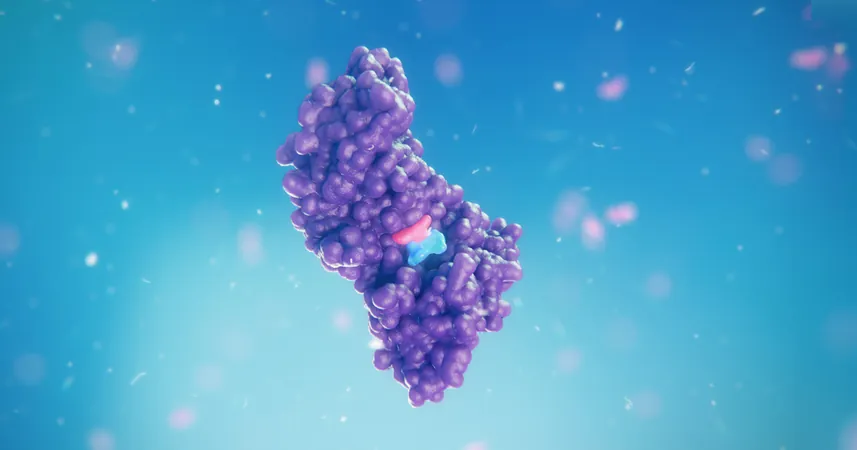
Unlocking Disease Treatment: Amgen's Game-Changing Approach to Medicine
2025-08-21
Author: Siti
A Revolution in Disease Intervention
For decades, traditional medicines have primarily followed a strategy of blocking biological processes—shutting down receptors, inhibiting enzymes, and preventing proteins from binding. While this method has led to major medical breakthroughs, it often falls short in the complex world of biological interactions. Our bodies are not mere toggle switches; they rely on intricate, fleeting interactions between molecules to function. Unfortunately, standard drugs struggle to effectively target these transient actions, especially when it comes to critical disease drivers that lack accessible binding sites.
Ryan Potts, the head of Amgen's Induced-Proximity Platform, posed a groundbreaking question: "What if we could intervene in those interactions differently?" Instead of merely blocking processes, Amgen is exploring whether it can enhance or stabilize these molecular interactions—or even lock them in a non-functional state to combat disease.
Introducing LOCKTACs: The Future of Therapy
This innovative thinking led Amgen to develop a new class of therapeutics known as LOCKTACs—molecular structures designed to act as "glue," tethering two naturally interacting molecules together more effectively than they could on their own. Through these LOCKTACs, the company aims to either boost beneficial molecular interactions or trap harmful ones, working in harmony with the body’s natural processes.
What's the Difference? Traditional vs. Induced Proximity
LOCKTACs stand out in the category of induced proximity therapeutics, which are designed to bring proteins close together. Unlike proteolysis-targeting chimeras (PROTACs), which recruit additional components to break down proteins, LOCKTACs stabilize their targets by keeping two molecules connected, adjusting their interactions and functions in ways that have never been achieved before.
Clinical Trials: A Step Towards Reality
Amgen isn’t just theorizing; it’s actively trialing LOCKTACs in clinical settings. For instance, their investigational drug AMG 193 aims to be a first-in-class, selective inhibitor of the enzyme PRMT5, particularly for solid tumors that lack the MTAP gene. In cancers lacking MTAP, a natural metabolite known as MTA accumulates and weakly inhibits PRMT5. AMG 193 is specifically engineered to stabilize the interaction between PRMT5 and MTA, thereby shutting down the enzyme more effectively, while minimizing toxicity to normal cells.
The Promise of Precision Medicine
According to Potts, LOCKTACs could usher in a new era of precision medicine: By leveraging existing cellular interactions, we can accurately tune biological processes, targeting disease precisely where needed and drastically reducing side effects. Furthermore, these molecules could enable us to tackle disease targets long considered 'undruggable.' However, the path to developing these advanced therapies is not without challenges; maintaining the right balance of geometry and strength for binding is crucial.
Harnessing Advanced Science for Drug Discovery
Amgen’s prowess in precision chemistry and protein engineering is vital as they navigate the complexities of designing LOCKTACs. These innovative molecules are compact, which helps uphold their drug-like properties, reducing the risk of off-target effects. The successful identification of target interactions requires significant biological knowledge, yet rapid advancements in structural biology, omics technologies, and computational modeling are expediting the discovery of new compounds.
Looking Ahead: A New Paradigm in Drug Development
As Amgen continues to evolve its understanding of induced proximity, LOCKTACs are poised to become a powerful tool in their drug discovery repertoire. Instead of simply reaching for the biological "off switch," they now have options to pause or hold critical molecular interactions. This nuanced approach could revolutionize how we target diseases and bring us closer to the ultimate goal: providing solutions for conditions that current medications cannot effectively address.

 Brasil (PT)
Brasil (PT)
 Canada (EN)
Canada (EN)
 Chile (ES)
Chile (ES)
 Česko (CS)
Česko (CS)
 대한민국 (KO)
대한민국 (KO)
 España (ES)
España (ES)
 France (FR)
France (FR)
 Hong Kong (EN)
Hong Kong (EN)
 Italia (IT)
Italia (IT)
 日本 (JA)
日本 (JA)
 Magyarország (HU)
Magyarország (HU)
 Norge (NO)
Norge (NO)
 Polska (PL)
Polska (PL)
 Schweiz (DE)
Schweiz (DE)
 Singapore (EN)
Singapore (EN)
 Sverige (SV)
Sverige (SV)
 Suomi (FI)
Suomi (FI)
 Türkiye (TR)
Türkiye (TR)
 الإمارات العربية المتحدة (AR)
الإمارات العربية المتحدة (AR)